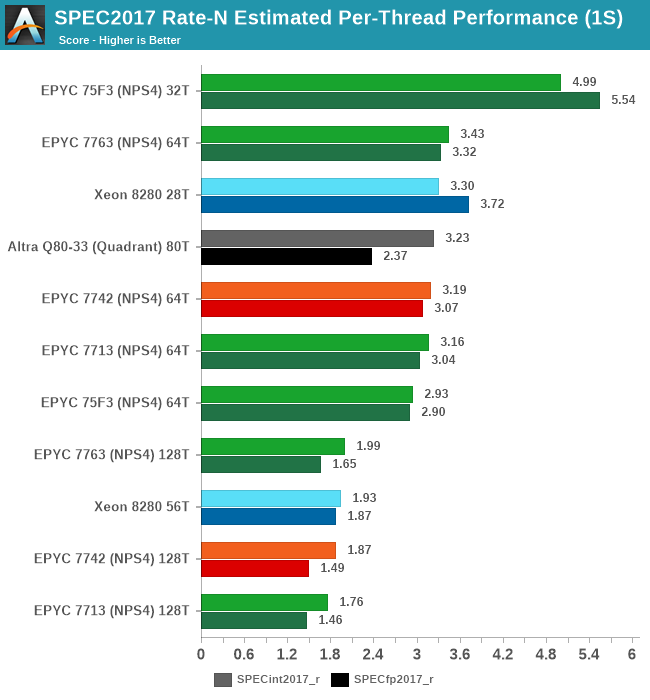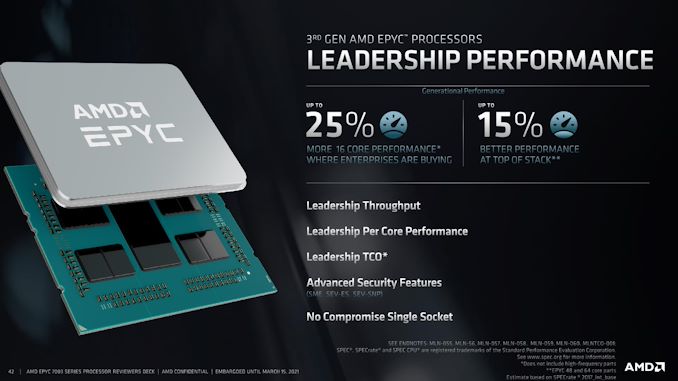AMD 3rd Gen EPYC Milan Review: A Peak vs Per Core Performance Balance
by Dr. Ian Cutress & Andrei Frumusanu on March 15, 2021 11:00 AM ESTDisclaimer June 25th: The benchmark figures in this review have been superseded by our second follow-up Milan review article, where we observe improved performance figures on a production platform compared to AMD’s reference system in this piece.
SPEC - Per-Core Win for "F"-Series 75F3
A metric that is actually more interesting than isolated single-thread performance, is actually per-thread performance in a fully loaded system. This actually is a measurement and benchmark figure that would greatly interest enterprises and customers which are running software or workloads that are possibly licensed on a per-core basis, or simply workloads that require a certain level of per-thread service level agreement in terms of performance.
It’s precisely this market that AMD is trying to target with its new “F”-series of processors, and this is where the new 75F3 comes into play. With 32 cores, 4 cores per chiplet with the full 256MB of L3 cache, and a base frequency of 2.95GHz, boosting up to 4.0GHz at a default 280W TDP, is the chip is squeezing out the maximum per-core performance while still offering a massive amount of multi-threaded performance.

At full load, this ends up with a massive per-thread performance leadership on the part of the 75F3, landing 45% ahead of the 7763 and 51% ahead of the Intel Xeon 8280.
It’s to be noted that limiting the thread count of the higher core-count SKUs will also result in a better per-thread performance metric, for example running a 7713 with only 32 threads will result in a SPECint2017 estimated score of 4.30 – the 75F3 still has a 16% advantage there even though its boost clock is only 8.8% higher at the peak – meaning the 75F3 is achieving higher effective frequencies. Unfortunately, we didn’t have enough time to do the same experiment on the equal 280W 7763 part.
AMD discloses that the biggest generational gains for the Milan stack is found in the lower core-count models, where for example the 7313 and the 7343 outperforms the 7282 and 7302 by 25%. Reason for this is that for example the new 7313 features double the L3 cache, and all the new CPUs are boosting higher with respectively higher TDPs, increasing to 150/190W from 120/155W, as well as landing in at +50% higher price points when comparing generation to generation.











120 Comments
View All Comments
Casper42 - Monday, March 15, 2021 - link
I'd really like to see you all test a 7543 to compare against the 75F3.If the Per Thread performance (Page 8) of that chip can beat the 7713, it might be a great option for VMware environments where folks want to stick to a single license/socket without needing the beastly 75F3
Casper42 - Monday, March 15, 2021 - link
PS: I think it will also help come April and I hope you test multiple 32c offerings then too.Olaf van der Spek - Monday, March 15, 2021 - link
Why don't these parts boost to 4.5 - 5 GHz when using only one or two cores like the desktop parts?ishould - Monday, March 15, 2021 - link
Hoping to get an answer to this tooCalin - Tuesday, March 16, 2021 - link
Basically if you have three servers at 50% load you shut one off and now deliver power to only two servers running at 75% load.An idle server will consume 100+ watts (as high idle power is not an issue for server farms) - so by running two servers at 75% versus three at 50% you basically save 100 watts.
(in many cases, server farms are actually power - i.e. electrical energy delivery or cooling - limited).
coschizza - Monday, March 15, 2021 - link
stabilityJon Tseng - Monday, March 15, 2021 - link
Probably something to do with thermals + reliability - recall in the datacenter theres a bunch of server blades stuffed into racks. Plus they are running 24/7. Plus the cooling system isn't generally as robust as on a desktop (costs electricity to run). Bottom line is that server parts tend to run at lower clocks than desktop parts for a mix of all of these reasons.Targon - Monday, March 15, 2021 - link
Server processors are NOT workstations, they are not intended for tiny workloads where there might only be a few things going on at one time. if you want more cores but want to use the machine like a workstation, you go Threadripper.yeeeeman - Monday, March 15, 2021 - link
quite underwhelming tbh..ballsystemlord - Monday, March 15, 2021 - link
You expected? AMD has been overwhelming for years now, give them some slack. They can't do it every year.